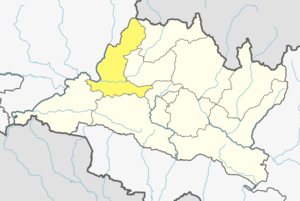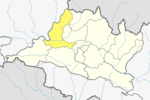| Dhading District धादिङ जिल्ला | |
|---|---|
| District | |
 Location of District in Bagmati Pradesh Location of District in Bagmati Pradesh | |
| Country | |
| Province | Bagmati Province |
| Admin HQ. | Dhading Besi |
| Government | |
| • Type | Coordination committee |
| • Body | DCC, Dhading |
| Area | |
| • Total | 1,926 km (744 sq mi) |
| Population | |
| • Total | 336,067 |
| • Density | 170/km (450/sq mi) |
| Time zone | UTC+05:45 (NPT) |
| Website | www |
Dhading District (Nepali: धादिङ जिल्ला Listen), a part of Bagmati Province, is one of the seventy-seven districts of Nepal. The district, with Dhading Besi as its district headquarters, covers an area of 1,926 square kilometres (744 sq mi), had a population of 338,658 in 2001 and 336,067 in 2011.
Geography and climate
Dhading District spreads from 27'40" E to 28'17" E and 80'17"N to 84'35"N. The mountain range Ganesh Himal is the predominant mountain range located within Dhading. Some of the peaks are over 7,000 metres (23,000 ft). The 8,000-metre (26,000 ft) and the mountain Manaslu is clearly visible from much of Dhading, although it is located within the bounds of Gorkha. The transnational Prithivi Highway connecting Kathmandu and Pokhara runs through the southern portion of the district, making for easy access to the Kathmandu valley. The road parallels the Trishuli River. The western border with Gorkha is bisected by the Budigandaki River.
The district is bounded by
- East: Kathmandu, Rasuwa and Nuwakot
- West: Gorkha
- North: Rasuwa and Tibet
- South: Makwanpur and Chitwan
Dhading is the only district of Nepal which ranges from the mountain Ganesh Himal to the Churevawar pradesh of Terai (Chitwan). The district, with Dhading Besi as its district headquarters, covers an area of 1,926 square kilometres (744 sq mi) and has a population (2001) of 338,658. Dhading is the district with the most rural municipalities in Nepal i.e. 11. The mountain range Ganesh is the predominant mountain range located within Dhading. All of the peaks are over 7,000 metres (23,000 ft) with some approaching 8,000 metres (26,000 ft). The over 8,000-metre (26,000 ft) mountain Manaslu is clearly visible from much of Dhading, although it is located within the bounds of Gorkha. The transnational King Prithivi Highway connecting Kathmandu and Pokhara runs through the southern portion of the district, making for easy access too the Kathmandu valley. The road parallels the Trishuli River. Dhading is 80% farmland and 20% forest. The western border with Gorkha is bisected by the Budhigandaki River.
| Climate Zone | Elevation Range | % of Area |
|---|---|---|
| Upper Tropical | 300 to 1,000 meters 1,000 to 3,300 ft. |
39.7% |
| Subtropical | 1,000 to 2,000 meters 3,300 to 6,600 ft. |
35.1% |
| Temperate | 2,000 to 3,000 meters 6,400 to 9,800 ft. |
10.8% |
| Subalpine | 3,000 to 4,000 meters 9,800 to 13,100 ft. |
7.7% |
| Alpine | 4,000 to 5,000 meters 13,100 to 16,400 ft. |
3.2% |
| Nival | above 5,000 meters | 2.5% |
The people of the district are primarily Bhramin and Chetri in the south and Tamang and Gurung in the north, with much of the center Newari. Gurkha route, the birthplace of founder of Nepal King Prithivi Naryan Shah crosses through Dhading.
Rivers
The main river of the Dhading district is Budi Gandaki which comes from Ganesh Himal and passes through Arughat Bazaar and Salyantar and meets Ankhu khola at Narsingha Dhamm. Budhi Gandaki separates the district from Gorkha district. The Trisuli River, which comes from Nuwakot, also passes through Dhading. There are 25 small rivers, the main being Charoudi, Malekhu, Galtukhola, Belkhukhola, Chiraudikhola, Maheshkhola, Aansi, Thopal, Manukhola, Kastekhola, and Mastekhola. Besides these, there are over 1743 smaller rivers, springs and seasonal streams.
Demographics
| Census year | Pop. | ±% p.a. | ||
|---|---|---|---|---|
| 1981 | 243,401 | — | ||
| 1991 | 278,068 | +1.34% | ||
| 2001 | 338,658 | +1.99% | ||
| 2011 | 336,067 | −0.08% | ||
| 2021 | 322,751 | −0.40% | ||
| ||||
| Source: Citypopulation | ||||
At the time of the 2011 Nepal census, Dhading district had a population of 336,067.
As their first language, 70.7% spoke Nepali, 20.1% Tamang, 2.5% Chepang, 2.1% Gurung, 1.9% Magar, 0.9% Newari, 0.7% Ghale, 0.5% Kumhali, 0.2% Bhojpuri, 0.1% Maithili, 0.1% Urdu and 0.2% other languages.
Ethnicity/caste: 22.2% were Tamang, 15.0% Hill Brahmin, 14.6% Chhetri, 9.4% Newar, 8.5% Magar, 5.6% Gurung, 4.8% Sarki, 4.3% Chepang/Praja, 4.2% Kami, 2.5% Damai/Dholi, 2.0% Ghale, 1.4% Kumal, 1.0% Gharti/Bhujel, 1.0% Sanyasi/Dasnami, 0.9% Thakuri, 0.7% Rai, 0.3% Danuwar, 0.3% Musalman, 0.2% Darai, 0.2% Majhi, 0.1% Brahmu/Baramo, 0.1% Kamar, 0.1% Tharu and 0.2% others.
The people of the district are primarily Brahmin and Chhetri in the south and Ghale, Gurung and Tamang in the north, with much of the center Newari.
Religion: 72.4% were Hindu, 20.6% Buddhist, 6.3% Christian, 0.3% Muslim, 0.2% Prakriti and 0.1% others.
Literacy: 62.7% could both read and write, 2.5% could read but not write and 34.7% could neither read nor write.
Religious temples
Dhading District has many religious temples. Among them is Tripurasundari Mai which lies in the northern part of the district. Siddha Than in Siddhalekh Rural Municipality is a Hindu religious site. Others include the Bhairabi Temple in Sunaula Bazar. Sri Nrsimha Dham Kshetra in Salyantar is a historical religious site for the Vedic Sanatan Hindu people, where Jagannath Foundation – Sri Rupanuga Para Vidyapeeth, Bimala Devi Temple, Shesa Temple, Sada Shiva and ancient Nrsimha Deva temple, and Ganga Jamuna temple are attractions. Kot Devi is a religious site in Jwalamukhi Rural Municipality, Maidi. Kalidevi Temple is also one of the popular religious temples (Devi Mandir) located in Dhunibeshi Municipality ward no. 6. Amleshwor Mahadev Temple in Mahesdovan, Jwalamukhi, is also one of the main religious temples of Dhading. Pasupatipati and Krishna mandir covers the district headquarter, Dhading Bensi. Madevthan of Palpa Bensi is also one of the religious sites of Dhading. Dhola Mandali temple of Dhola is a popular Hindu temple. Every Tuesday people used to cut she-goats in Mandali Thaan. Girls and women are not allowed to go there.The origin of the Muktinath temple of Mustang is Dhading. In Dhading, Muktinath Temple is located at Siddhalek Rular Municipality, nearly Kalupanda Marg.
Administration
Dhanding district consists of two municipalities and 11 rural municipals.
Municipalities
Rural municipals
- Khaniyabas
- Gajuri
- Galchhi
- Gangajamuna
- Jwalamukhi
- Thakre
- Netrawati Dabjong
- Benighat Rorang
- Rubi Valley
- Siddhalek
- Tripurasundari
Towns and villages

- Dhunibeshi Municipality
- Khanikhola
- Naubise
- Gaucharan
- Dharke
- Jungekhola
- Madhevbeshi
- Simle
- Aginchok
- Baireni
- Baseri
- Benighat
- Bhumesthan
- Budhathum
- Chainpur
- Chhatre Dyaurali
- Dangsing
- Darkha
- Dhola
- Dhusha
- Dhuwakot
- Gajuri
- Gaunkharka
- Gerkhu
- Ghussa
- Goganpani
- Gumdi
- Jharlang
- Jiwanpur
- Jogimara
- Jyamaruk
- Kalleri
- Katunje
- Kebalpur
- Khalte
- Khari
- Kiranchok
- Kumpur
- Lapa
- Mahadevsthan
- Maidi
- Marpak
- Mulpani
- Murali Bhanjyang
- Nalang
- Naubise
- Nilkantha Municipality
- Phulkharka
- Pida
- Ranibari
- Rigaun
- Salang
- Salyankot
- Salyantar
- Sangkosh
- Satyadevi
- Semjong
- Sirtung
- Sukabhanjyang
- Sunaula Bazar
- Tasarphu
- Thakre
- Tipling
- Tripureshwar
See also
- Charaundi (Commercial zone)
- Zones of Nepal
References
- ^ "National Population and Housing Census 2011(National Report)" (PDF). Central Bureau of Statistics. Government of Nepal. November 2012. Archived from the original (PDF) on 2013-04-18.
- ^ "Nepal Census 2001". Nepal's Village Development Committees. Digital Himalaya. Archived from the original on 12 October 2008. Retrieved 12 December 2008.
- "District Development Committee, Dhading".
- The Map of Potential Vegetation of Nepal - a forestry/agroecological/biodiversity classification system (PDF), Forest & Landscape Development and Environment Series 2-2005 and CFC-TIS Document Series No.110., 2005, ISBN 87-7903-210-9, archived from the original (PDF) on December 3, 2013, retrieved Nov 22, 2013
- Book:Jilla Bastugat Biwaran:Dhading-2064, Page 3, Language: Nepali, Nepal Government Publication
- "NEPAL: Administrative Division". www.citypopulation.de.
- NepalMap Language
- NepalMap Caste
- NepalMap Religion
- NepalMap Literacy
External links
27°52′0″N 84°55′0″E / 27.86667°N 84.91667°E / 27.86667; 84.91667
| Provinces and Districts of Nepal | ||
|---|---|---|
| Koshi | ||
| Madhesh | ||
| Bagmati | ||
| Gandaki | ||
| Lumbini | ||
| Karnali | ||
| Sudurpashchim | ||
| Dhading District | ||
|---|---|---|
| Headquarters: Dhading Besi | ||
| Gaunpalika |  | |
| Municipalities | ||